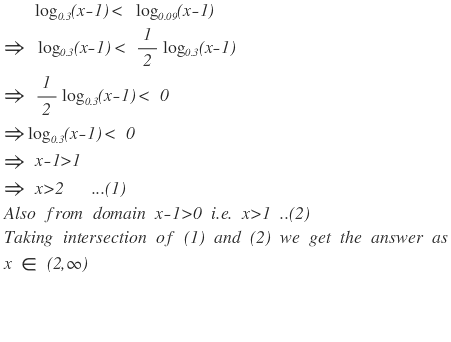Logarithm Basics Part II
lo g 0 . 3 ( x − 1 ) < lo g 0 . 0 9 ( x − 1 ) The values of x satisfying the above inequality are?
Join the Brilliant Classes and enjoy the excellence.
This section requires Javascript.
You are seeing this because something didn't load right. We suggest you, (a) try
refreshing the page, (b) enabling javascript if it is disabled on your browser and,
finally, (c)
loading the
non-javascript version of this page
. We're sorry about the hassle.
2 solutions
After getting ( x − 1 ) 2 > x − 1 we can divide both sides by x − 1 as from the domain we know that x − 1 > 0 , this would straight away give us x − 1 > 1 .
Sir I simply thought that
1 is not possible .
For x=2. They will be equal so the answer that follows is (2,infinity)
A typo in the second step identity, it is actually :
l o g B A = l o g B l o g A .
Log in to reply
Thanks for figuring it out..I've corrected it. Karthik Venkata
Why must the inequality be reversed when multiplied by a positive integer ??
Log in to reply
l o g ( 0 . 3 ) is not a positive integer, it is a negative number.
But sir there is a property of log in which l o g 0 . 0 9 can be directly written as 2 1 l o g 0 . 3 .So the inequality won't be reversed..
Log in to reply
Still the inequality will be reversed on cancelling l o g 0 . 3 from both sides. And if you don't cancel then :
If l o g a x 1 > l o g a x 2 and 0 < a < 1 , then x 1 < x 2 . So it is same as cancelling and reversing the inequality.
Moderator note:
Always be careful with logarithms of a base that is smaller than 1. Inequalities often end up working the other way.
Because of that, I tend to prefer to view lo g n 1 as − lo g n instead.

l o g 0 . 3 ( x − 1 ) < l o g 0 . 0 9 ( x − 1 )
⟹ l o g ( 0 . 3 ) l o g ( x − 1 ) < l o g ( 0 . 0 9 ) l o g ( x − 1 ) ( l o g B A = l o g B l o g A )
⟹ l o g ( 0 . 3 ) l o g ( x − 1 ) < 2 ⋅ l o g ( 0 . 3 ) l o g ( x − 1 )
⟹ l o g ( x − 1 ) 2 > l o g ( x − 1 ) (Inequality reversed...think : why ???)
⟹ x 2 − 2 x + 1 > x − 1
⟹ x 2 − 3 x + 2 > 0
⟹ x ∈ ( − ∞ , 1 ) ∪ ( 2 , ∞ ) . . . . . . . . . . . . . ( 1 )
But taking domain of l o g into consideration :
x − 1 > 0
⟹ x > 1 . . . . . . . . . . . . ( 2 )
So combining ( 1 ) & ( 2 ) , the values of x satisfying the above inequality are ( 2 , ∞ )
enjoy!